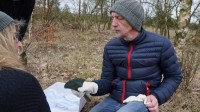 Just before Easter of this year, Christmas tree farmer Esben Arildskov asked a metal detecting friend Bent Rasmussen to survey a field on his farm in the village of Boest near Nørre Snede in Jutland, Denmark. Bronze artifacts had been found on the field before, and Arildskov wanted to be sure any historic artifacts were recovered before he cleared the area for planting. That responsible choice proved prescient. Rasmussen’s metal detector alerted to a large metal find and when he dug down, he found two large bronze axe heads. He immediately stopped digging and notified experts at the Museum Midtjylland of the find.
Just before Easter of this year, Christmas tree farmer Esben Arildskov asked a metal detecting friend Bent Rasmussen to survey a field on his farm in the village of Boest near Nørre Snede in Jutland, Denmark. Bronze artifacts had been found on the field before, and Arildskov wanted to be sure any historic artifacts were recovered before he cleared the area for planting. That responsible choice proved prescient. Rasmussen’s metal detector alerted to a large metal find and when he dug down, he found two large bronze axe heads. He immediately stopped digging and notified experts at the Museum Midtjylland of the find.
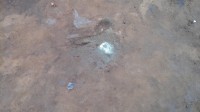 The two axes Rasmussen unearthed are 30 and 26 centimeters (one foot and 10 inches) long. The larger one weighs almost a full kilo (980 grams, 2.16 pounds); the smaller weighs 650 grams (1.4 pounds). Bronze Age axes are usually half this size, so the museum’s archaeologists were excited by the find. They examined the site and realized there was more to be found underneath the surface. They had to wait until after Easter to get started so on April 7th the official excavation began. Archaeologists, museum curators, journalists, neighbors and interested observers made the dig something of a party, complete with coffee and homemade cake. They had good cause to celebrate when three more oversized axes were unearthed. The axe hoard was painstakingly buried, each axe placed deliberately on top of the others inside a pit that was padded with grass.
The two axes Rasmussen unearthed are 30 and 26 centimeters (one foot and 10 inches) long. The larger one weighs almost a full kilo (980 grams, 2.16 pounds); the smaller weighs 650 grams (1.4 pounds). Bronze Age axes are usually half this size, so the museum’s archaeologists were excited by the find. They examined the site and realized there was more to be found underneath the surface. They had to wait until after Easter to get started so on April 7th the official excavation began. Archaeologists, museum curators, journalists, neighbors and interested observers made the dig something of a party, complete with coffee and homemade cake. They had good cause to celebrate when three more oversized axes were unearthed. The axe hoard was painstakingly buried, each axe placed deliberately on top of the others inside a pit that was padded with grass.
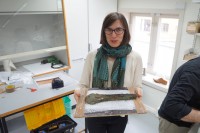 Radiocarbon dating found the axes were made between 1,800 and 1,500 B.C., a period bridging the end of the Stone Age and the beginning of the Bronze Age. This places them among the earliest bronze artifacts ever discovered in Denmark.
Radiocarbon dating found the axes were made between 1,800 and 1,500 B.C., a period bridging the end of the Stone Age and the beginning of the Bronze Age. This places them among the earliest bronze artifacts ever discovered in Denmark.
Bronze axes from this era are so rare only five of them have been found before in Denmark, Sweden and northern Germany. That means the Boest find has in one fell swoop doubled the number of these Bronze Age axes in the archaeological record of northern Europe. When you consider that
Bent Rasmussen and his brother, enlisted by Bent during excavations to cover more ground with their metal detectors, found another four smaller axes and a spear tip, it’s clear that this field in Boest was an important place during the early Bronze Age.
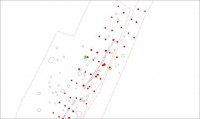 The would-be Christmas tree lot continued its archaeological hot streak when rows of large postholes were discovered. Four parallel rows of holes so large the posts they held would have been at least the height of a man. At first archaeologists thought they might be the remains of a dwelling or a fence, but as they kept excavating they kept finding more postholes. Ultimately they were able to follow an uninterrupted path of postholes for 109 meters before it disappeared into the forest. Now they’re thinking it may have been a processional route leading to burial mounds known to be on the property. This find is unique in Danish history, more akin to the pre-stone standing structures of Avebury and Stonehenge. Archaeologists hope to be able to excavate the entire processional in the near future, but first the funding has to be secured.
The would-be Christmas tree lot continued its archaeological hot streak when rows of large postholes were discovered. Four parallel rows of holes so large the posts they held would have been at least the height of a man. At first archaeologists thought they might be the remains of a dwelling or a fence, but as they kept excavating they kept finding more postholes. Ultimately they were able to follow an uninterrupted path of postholes for 109 meters before it disappeared into the forest. Now they’re thinking it may have been a processional route leading to burial mounds known to be on the property. This find is unique in Danish history, more akin to the pre-stone standing structures of Avebury and Stonehenge. Archaeologists hope to be able to excavate the entire processional in the near future, but first the funding has to be secured.
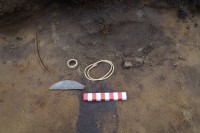 At the end of April, archaeologists unearthed another treasure across the post rows and slightly to the right of the axe hoard: two gold bracelets, one gold finger ring and two flint blades. The bangles weigh 21 grams (.74 ounces) apiece while the ring weighs a massive 16 grams (.56 oz). Modern wedding rings weigh a single gram, so this ring is exceptionally heavy. The gold deposit also dates to the transitional period between the Stone and Bronze Ages.
At the end of April, archaeologists unearthed another treasure across the post rows and slightly to the right of the axe hoard: two gold bracelets, one gold finger ring and two flint blades. The bangles weigh 21 grams (.74 ounces) apiece while the ring weighs a massive 16 grams (.56 oz). Modern wedding rings weigh a single gram, so this ring is exceptionally heavy. The gold deposit also dates to the transitional period between the Stone and Bronze Ages.
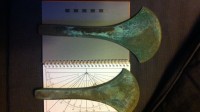 The axes are being conserved at the Museum Midtjylland after which they will be sent to the National Museum in Copenhagen for further analysis. Museum Midtjylland hopes the axes will be available for display this summer. Esben Arildskov has accepted that he won’t be planting Christmas trees on this land anytime soon, but he’s consoled by the fact that he’s the owner of a Bronze Age ceremonial center with huge axes and gold rings the weight of 16 regular rings buried hither and yon. He, his wife Birthe Rosvig and two daughters (aged five and eight) are thrilled to have found actual treasure in their back yard.
The axes are being conserved at the Museum Midtjylland after which they will be sent to the National Museum in Copenhagen for further analysis. Museum Midtjylland hopes the axes will be available for display this summer. Esben Arildskov has accepted that he won’t be planting Christmas trees on this land anytime soon, but he’s consoled by the fact that he’s the owner of a Bronze Age ceremonial center with huge axes and gold rings the weight of 16 regular rings buried hither and yon. He, his wife Birthe Rosvig and two daughters (aged five and eight) are thrilled to have found actual treasure in their back yard.
A wonderful discovery which reflects and highlights the need for all nations to enact strong Laws that any time excavation and/or new construction on land, (whether deep or shallow), is undertaken, a certificate must be signed attesting to the fact that “Metal Detecting Equipment has been employed to certify that there are no archaeological items of interest to be discovered.
It is just fortunate that this individual land owner felt inclined to undertake land inspection protocols which produced such incredible discoveries of objects thousands of years old.
One shudders to contemplate that these recent finds likely represent just a fraction of a fraction of a fraction of one percent of all the potential finds the world will never know about as millions of acres of land, world wide, are yearly bulldozed up and then expeditiously covered over with millions of tons of steel and cement and high rise buildings.
The 1922 discovery by Howard Carter and George Herbert, 5th Earl of Carnarvon of Tutankhamun’s nearly intact tomb in Egypt’s Valley of the Kings received worldwide press coverage and remains perhaps one of the greatest archaeological discoveries in the history of the world even to this day.
But how much of our collective past has never been discovered and never will be unearthed as vast areas of the Earth are continuously bulldozed into oblivion and covered over in the name of progress.
This makes even such modest discoveries as discussed here that much more precious and the curious farmer who was responsible that much more deserving of the highest praise.
It is sad that it does not appear that anyone thought to reward this humble farmer in any significant or appreciable way for his huge contributions to historical Scholarship.
Perhaps if there had been more effort to celebrate and fairly compensate this man for his wise efforts, then more people would try to emulate his actions.
That failure will only increase the chances that in the future, there will result fewer rather than more, discoveries of equal importance.
Is this, in the end, not exceedingly sad and a loss for all Humanity ?
Who can know and/or even begin to imagine what amazing potential discoveries continue to remain, buried deep in the Earth, out of all sight, far from day light and beyond our awareness and knowledge.
Those oversized bronze axes clearly indicate a Bronze Age Christmas tree farm. 🙂
I agree with you, however, your well-worded argument brings to mind a story about archeology in Egypt: Somewhere in the Nile delta, archeologists discovered clear evidence of a major settlement from the pharaonic era. A city thought to rival Thebes or the (later) Alexandria. Most of the land they wanted to excavate to explore the site was owned by a local farmer. Who refused to sell and/or allow archeological exploration on his land. According to him “You can find antiquities everywhere, good farmland is rare”.
I was replying to DavidPakter’s comment. Somehow the ‘reply to this comment’ option never works for me.
Thanks for another great article. What an incredible group of finds! I can’t believe the condition of those axe heads, they look almost new after conservation.
I wonder how they used radiocarbon dating to determine their age? I didn’t think that method would work on bronze. Maybe they dated the grass lining the burial pit?
What beautifully crafted items! Were they battle axes, tree cutting axes or both?
Those extra-large bronze axes obviously point to a Bronze Age Christmas tree farm.